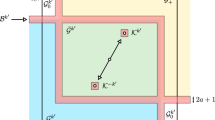Abstract
In this paper, we calculate the region of emergence of rogue waves in the Sasa–Satsuma equation by performing Penrose stability analysis. We consider Wigner-transformed Sasa–Satsuma equation and separate out unstable solutions, namely Penrose instability modes. We superpose these modes in a small region. With the help of marginal property of the Wigner transform, we identify the region in which rogue wave solution can emerge in the Sasa–Satsuma equation and calculate the amount of spatial localization. We also formulate a condition for the emergence of rogue wave solution in the Sasa–Satsuma equation.

Similar content being viewed by others
References
O. Kimmoun, H.C. Hsu, B. Kibler, A. Chabchoub, Phys. Rev. E 96, 022219 (2017)
Y.H. Ichikawa, T. Suzuki, T. Taniuti, J. Phys. Soc. Jpn. 34, 1089 (1973)
D. Mestdagh, Opt. Lett. 13, 829 (1988)
J. Zhang, L. Wang, C. Liu, Proc. R. Soc. A 473, 20160681 (2017)
M. Remoissenet, Ann. Telecommun. 51, 7–8 (1996)
O. Penrose, Phys. Fluids 3, 258–265 (1960)
S.A. Rybak, O.M. Zozulyal, Phys. A 241, 128–132 (1997)
T.B. Benjamin, J.E. Feir, J. Fluid Mech. 27, 417–430 (1967)
M.J. Lighthill, J. Inst. Math. Appl. 1, 269–306 (1965)
V. E. Zakharov, Zh. Prikl. Mekh. i Teckhn. Fiz. 9, 86-94 (1968). Transl. J. Appl. Mech. and Tech. Phys. 9, 190-194 (1968)
M. Onorato, A.R. Osborne, M. Serio, Phys. Rev. Lett. 96, 014503 (2006)
N. Akhmediev, A. Ankiewicz, M. Taki, Phys. Lett. A 373, 675–678 (2009)
A.G. Athanassoulis, G.A. Athanassoulis, T.P. Sapsis, J. Ocean Eng. Mar. Energy 3, 353–372 (2017)
A. Assaubay, A.J. Castro, A.A. Valido, Phys. D Nonlinear Phenom. 411, 132587 (2020)
N. Akhmediev, J.M. Soto-Crespo, N. Devine, N. Hoffmann, Phys. D Nonlinear Phenom. 294, 34–42 (2015)
U. Bandelow, A. Ankiewicz, Sh. Amirananshvilli, N. Akhmediev, Chaos 28, 053108 (2018)
U. Bandelow, N. Akhmediev, Phys. Rev. E 86, 026602 (2012)
U. Bandelow, N. Akhmediev, Phys. Lett. A 376, 1558–1561 (2012)
S. Chen, Phys. Rev. E 88, 023202 (2013)
L. Zhao, S. Li, L. Ling, Phys. Rev. E 93, 032215 (2016)
J.J.C. Nimmo, H. Yilmaz, J. Phys. A Math. Theor. 48, 425202 (2015)
E. Wigner, Phys. Rev. 40, 749–759 (1932)
J. Weinbub, D.K. Ferry, Appl. Phys. Rev. 5 (2018)
W.B. Case, Am. J. Phys. 76, 937–946 (2008)
A.G. Athanassoulis, Appl. Comput. Harmon. Anal. 24, 378–392 (2008)
W. Vogel, D.G. Welsch, Quantum Optics (Wiley-WCH, Weinhei, 2009)
A. G. Athanassoulis, G. A. Athanassoulis, M. Ptashnyk , T. P. Sapsis, arXiv:1808.05191v1 (2018)
G. Mu, Z. Qin, Nonlinear And: Real world Appl. 31, 179 (2016)
G. Mu, Z. Qin, R. Grimshaw, N. Akhmediev, Phys. D 102 (2020)
K.M.M. Prabhu, Taylor and Francis group, USA (2013), pp. 87–126
Acknowledgements
MP acknowledges the Bharathidasan University, Tiruchirappalli, for providing a University Research Fellowship (URF). NVP wishes to thank IISc, Bangalore, for providing a fellowship in the form of Research Associateship. The work of MS forms part of a research project sponsored by NBHM, Government of India. Funding was provided by National Board for Higher Mathematics (Grant No. 02011/20/2018NBHM(R.P)/R&D 24II/15064).
Author information
Authors and Affiliations
Corresponding author
Appendix: Construction of Wigner-SSE
Appendix: Construction of Wigner-SSE
In this Appendix, we formulate Wigner-SSE for Eq. (2) by utilizing Wigner transform and its properties. Using Fourier convolution theorem, we can rewrite the nonlinear terms in the required form. Using Eq. (6), we can rewrite the group velocity dispersion term as
Similarly, the third-order dispersive term in (7) (second term) can be rewritten in the form
The self-phase modulation term \(T_3\) [third term in Eq. (7)], can also be rewritten in an exact Wigner form with the help of the convolution theorem of Fourier transform (after replacing \(|q|^2=U(x,t)\)), that is
In the self-frequency shift term \(T_4\) [fourth term in Eq. (7)], we have the spatial derivative of U(x, t). We keep this term as it is and rewrite this term as
To rewrite the last term (\(T_5\)), we use the properties (5a) and (6). After imposing these properties and through the convolution, the last term can be brought to the form
Replacing the right-hand side of Eq. (7) with the above expressions (40)–(44), we obtain the Wigner-SSE which is given in Eq. (8) in Sect. 2 with \(U(x,t)=\displaystyle \int _\varLambda W(x,\varLambda ,t)~\mathrm{d}\varLambda \) owing to the marginal of the Wigner transform.
Rights and permissions
About this article
Cite this article
Pradeepa, M., Vishnu Priya, N. & Senthilvelan, M. Penrose instabilities and the emergence of rogue waves in Sasa–Satsuma equation. Eur. Phys. J. Plus 136, 591 (2021). https://doi.org/10.1140/epjp/s13360-021-01570-1
Received:
Accepted:
Published:
DOI: https://doi.org/10.1140/epjp/s13360-021-01570-1




